Today the California Public Utilities Commission approved a nearly two-year pilot project for residential rates for plug-in electric vehicle charging for San Diego Gas & Electric.
The first 1,000 SDG&E customers who buy a Nissan LEAF will receive free home charging equipment, courtesy of ECOtality, which received a $99.8 million DOE grant to help fund the deployment of EV charging stations in cities across five states, including San Diego. The project will also provide approximately 1,500 220-volt stations and 50 330-volt fast chargers.
"The Study will help the state better understand the impacts of different rate structures on how and when customers charge electric vehicles," CPUC President Michael R. Peevey said in a statement. The utility will likely use the results of this study for setting EV charging rates moving forward.
The pilot is running on the premise that greater variation in time-of-use pricing and easily accessible charging will shift customers to plugging in during off-peak hours. However, while it's true that people like to save money, the intersection of convenience versus cost savings is still a black hole of knowledge when it comes to EVs coming into the market.
Customers who receive free home-charging infrastructure will be enrolled in one of three temporary electric vehicle rate categories. Each level was assigned rates for on- and off-peak summer and winter usage.
The low group will be charged between $0.14-$0.17 per kilowatt hour for off-peak summer usage and all winter usage, and about $0.27 during peak summer hours.
The next group has a greater variation, with super off-peak rates being as low as $.076 in summer and summer peak reaching nearly $0.30 per kWh.
The high ratio group will be subject to an even greater spread, with charging rates as low as $0.067 in off-peak summer, contrasted with $0.33 and $0.38 per kWh for on-peak winter and summer usage, respectively.
The study hopes to answer some questions that all utilities are trying to sort through, including the range of price differences that will effectively compel consumers to charge off-peak, the ways in which availability of charging stations will affect when consumers plug in, and what load profiles will look like as EVs come onto the market.
The pilot will run from January 1, 2011 through November 2012.



